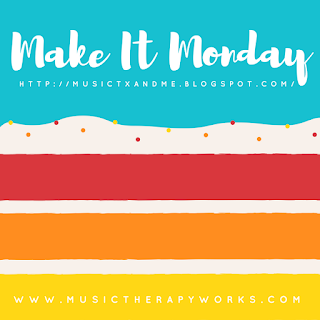Make It Monday: Taking a File Folder Pattern and Making It into a Therapeutic Music Experience (TME)
I feel very strongly that the materials that I use in my clinic have some sort of need for music in order to be used in music therapy. I don't really feel that just adding a song to an existing something (idea, visual aid, etc.) is really music therapy, but there's a place for the use of music in that manner. I want the music to drive the activity, not just be an accompaniment. I often wonder if I am the only person who feels this way, but then I re-read Bruscia's Defining Music Therapy and know that I am not alone.
I often find really cool, free file folder kits on various social media sites, and I take advantage by downloading and making them into folders. It is hard to resist, especially when things are free. I then either put those folders into my storage areas or figure out some way to incorporate these visual aids into music therapy by developing TMEs to go with the visual aids.
The rule for me is that the music has to drive the TME - the reason for using the visual aid has to be to move clients towards their music therapy goals and objectives. As a result, I often compose songs to go with visuals that I have and then develop those songs further to stand alone without the visual aid. Maybe that's the real thing that I want in my clinic - TMEs that don't need a visual aid, but that are enriched by the visual format.
If I can't come up with a TME that can stand alone without the visual aid, then the TME is not what I would consider to be music therapy. Anyone can use a visual aid and sing a song - that's not music therapy. For something to be considered music therapy (in my mind and OPINION), there has to be an element that is part of the therapeutic relationship and additionally, elements of music that are changed to accommodate the client within that relationship.
Ooh.
Back to the original thought.
I found a really cute file on social media about pets and their homes. (If you like this file, check out the download at totschooling.net for your own copy of the file!!) I've made five versions* of this folder for use with some of my clients. I have this wonderful resource and it is just sitting there, waiting for a TME to go along with it.
I color-coded this folder as an academic/cognitive focus (hence, the yellow folders). That is just one way it can be used - matching pets to their homes. We can also spend some time imagining life in a cage or a bowl of water. I haven't really found other ways to make this work...yet. This could be the impetus for some creative movement - move like a lizard, etc. So far, though, I have nothing that makes the use of this folder something that only a music therapist can do.
Time to keep brainstorming. Let me go into my song files for something that I could use to frame the use of this resource. I have pet songs. I could find pet care songs. I can write songs (of course!!). Still, nothing about this string of brainstorming can really justify using this file folder in my music therapy sessions.
We could pull these visual aids into coping skill development. Many of my students struggle with learning how to cope with frustration, anger, sadness, joy - this may be something that could remind them of specific techniques for those emotions. (Getting closer to a TME, but still not there...)
I'll continue this process until I have a full TME fleshed out for use with my clients. Some clients will use this visual as a cognitive/academic task, matching animals to their pet habitats. Other clients will use this to prompt life long leisure skill development - making songs to prompt appropriate pet care. Yet others will use this visual to prompt coping skills practiced in music therapy and other therapeutic environs. The visual aid will become a tool to support the music rather than the purpose behind using the music. At that point, I will be ready to use this in my music therapy sessions, and I will have my six separate ways to use this visual!
Bruscia, K. (2014). Defining Music Therapy (3rd ed.). University Park, IL: Barcelona Publishers.
*Wondering why I made five versions of this folder? Well, I want to make sure that my clients are actually looking at the task rather than just learning the task and completing it without any type of cognitive engagement. By changing the order of the visuals, my clients have to look and see which version they have in front of them. I use these for large groups of clients, so I make four file folders for four smaller groups and keep one folder pristine in my archive of stuff.



Comments
Post a Comment